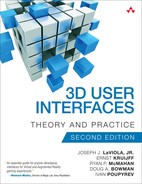FOREWORD TO THE SECOND EDITION
It seems like yesterday that the first edition of this book was published. However, yesterday was over a dozen years ago—just in time for me to adopt it for the 3D user interface course I have been teaching ever since. The first edition was the ambitious and successful first text devoted to this subject. A timely and welcome gift to our field, it was the product of a team of authors actively engaged in leading-edge research, who codified and successively refined their work through the development of a series of tutorials out of which their book grew.
As Jim Foley wrote in his foreword to the first edition, “Three-dimensional user interfaces are finally receiving their due!” But, exhilarating though the times were then, the intervening years have brought us even more exciting advances. As I write this, virtual reality is becoming consumer reality, with tethered head-worn displays connected to desktop computers and mobile head-worn displays powered by phones—all superior in many ways to the orders-of-magnitude more expensive systems that were found in research labs back when the first edition appeared. Meanwhile, hand-held augmented reality games have become international sensations, downloaded hundreds of millions of times, and early commercial head-worn augmented reality displays are already in the hands and on the heads of eager developers.
Simply put, the processing and display technology needed for interactive 3D is now commonplace. The graphics power of current smartphones is comparable to that of full-size game consoles that debuted after the first edition was published. Hardware and software for accurately tracking the 3D position and orientation of a smartphone or a user’s head and for capturing full hand and body pose are now integrated into an increasing number of those phones. Even smartwatches can run 3D applications.
But amidst this thrilling democratization of 3D, there is a problem. Powerful processors, high-quality displays, responsive interaction devices, and efficient software by themselves are not enough to make 3D useful. These technologies need to be combined together in the right way to create effective 3D user interfaces. However, the vast majority of user interface designers and developers are only knowledgeable about and comfortable with 2D user interfaces. What can be done about this?
That’s where this book comes in. Joe LaViola, Ernst Kruijff, Doug Bowman, and Ivan Poupyrev—the authors of the first edition—have joined with Ryan McMahan. Together, they have given us this extensively updated second edition, which provides the thorough background needed to understand current 3D user interfaces and the software and hardware from which they are built. Like its predecessor, the second edition teaches the reader how to design, implement, and evaluate 3D user interfaces, summarizing and categorizing decades of ongoing research and practice. Two extended application case studies are threaded throughout the book, offering substantial examples of how to make appropriate choices from among the possibilities described, whether high-level design, displays, input devices, interaction techniques, or evaluation approaches.
Many of the technologies underlying 3D user interfaces are different from those used in 2D user interfaces, have not undergone the same level of standardization, and are more actively evolving. Yet there is one constant: people. Recognizing this, the authors dedicate several substantial chapters to the perceptual, cognitive, and physical bases, as well as to the principles of human–computer interaction for how we interact in and with the 3D world. By grounding the book in a principled understanding of users, they help guide us toward the design of effective 3D user interfaces that honor our abilities and respect our limitations.
I’m looking forward to using the second edition in my course at Columbia. And whether you’re a seasoned researcher or practitioner, or a fresh convert to the power of 3D interaction, you’re also in for a treat!
Steve Feiner
Department of Computer Science
Columbia University
January 2017
